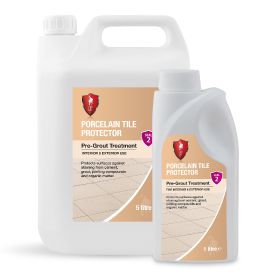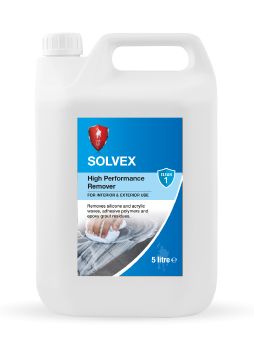
Textured porcelain pavers continue to be incredibly popular for paths and patios and, for many installers, pre-mixed brush-in resin grouts are the preferred fixing method. Unlike traditional sand and cement grouts, resin-based products combine an epoxy resin with a filler. This provides many benefits, including greater bond strength, durability and resistance to water, stains and chemicals. However, brush-in resins can be more difficult to work with and can easily stain tiles, often leaving an unsightly white haze or dark frame around the edge of the tile.
How to protect a new porcelain installation
If you’re installing new matt porcelain outdoors and using a resin grout, staining can be avoided by using a barrier treatment to protect the tile. We recommend LTP Porcelain Tile Protector, which provides a number of benefits: It prevents grout and resins from taking hold; it makes the removal of any residues much easier and it improves and increases grout working times. A further coat applied after installation will make ongoing maintenance easier too.
How do I apply LTP Porcelain Tile Protector (youtube.com)
What is the difference between a sealer and a barrier?
Much confusion still exists in terms of porcelain barrier treatments and how they differ from sealers. The formulation of our own Porcelain Tile Protector is very different to that of our sealers, which have smaller ‘actives’ and, in the case of MPG Sealer, contain nano waxes. Also, the carrier within our Protector is mildly acidic. This allows for deeper penetration into the fissures of textured porcelain tiles, where it then dries and leaves the active ingredients behind. As they dry, they cross link within the low points of the glaze. This provides protection against penetration from cement and resin-based grouts, making the removal of any residues much easier. The Protector is completely invisible once cured, so it doesn’t alter the appearance of the porcelain. Whilst the treatment is primarily used as a pre-grout solution, it can also be applied to existing pavers – once they have been thoroughly cleaned – to make ongoing cleaning easier.

Before the Protector is applied, the tiles should be cleaned and left to dry overnight. The treatment is then applied with a broad paint brush or light pressure sprayer and left to dry for 30 minutes before applying a second coat. The treatment should be left to cure for a minimum of one hour before grouting. Once the grout is dry, and all residues have been removed, a further coat of Protector can be applied to the tiles and the grout joint.
How to remove resin stains from existing installations
To remove epoxy resin grout residue and white haze from existing installations, without damaging the joint or the paver, we recommend LTP Solvex – a non-caustic intensive cleaner/stripper. Solvex helps to soften the resin residues, allowing for easier removal from the textured porcelain. Application is normally followed by a final wash with LTP Grimex cleaning solution before rinsing down. As well as tackling brush-in resin grout, LTP Solvex can be used to remove wax, oil, silicone, acrylic and polyurethane sealer from porcelain.


A good ongoing maintenance regime
As with indoor tiles, porcelain paths and patios will benefit from a periodic clean. Keeping the surface relatively clean will prevent a build-up of dirt in the textured surface, making ongoing maintenance easier and retaining the tile’s slip resistance. As a general rule of thumb, it’s worth cleaning paving every couple of months or so – ideally, three times during late spring/summer and twice during the winter. Regular cleaning of inside-to-outside surfaces, like those that run through bifold doors, will also help maintain a seamless aesthetic. Jet washing may seem like the best method for a fast clean but it will only wash dirt off the surface of the slabs. High pressure water will also damage grout joints. A specialist treatment, like LTP Grimex, will react with the dirt and organic matter, and will help break it down. Meanwhile, a build-up of algae can be treated with LTP Blackspot & Algae Remover – a treatment that’s designed to break down microspores and black spot ‘hyphae’ before they colonise and help prevent future staining.
Patio Black spot removal in 2 minutes (youtube.com)
To find out more about protection and maintenance, please visit https://www.ltp-online.co.uk or contact the LTP team on tel. 01823 666213 and email [email protected]. Also, for online help on-the-go, visit LTP TV on YouTube and Product Selector at https://ltp-productguide.co.uk



